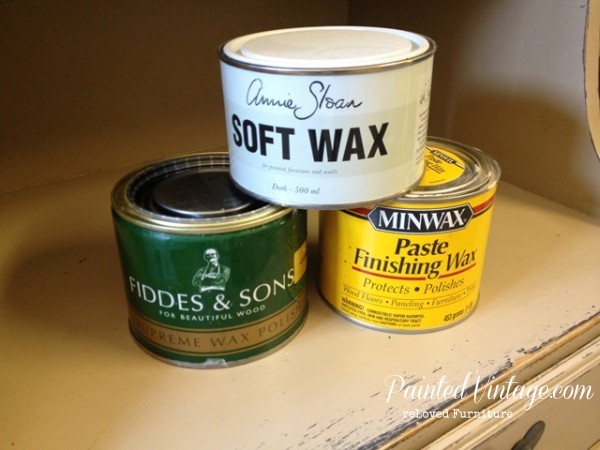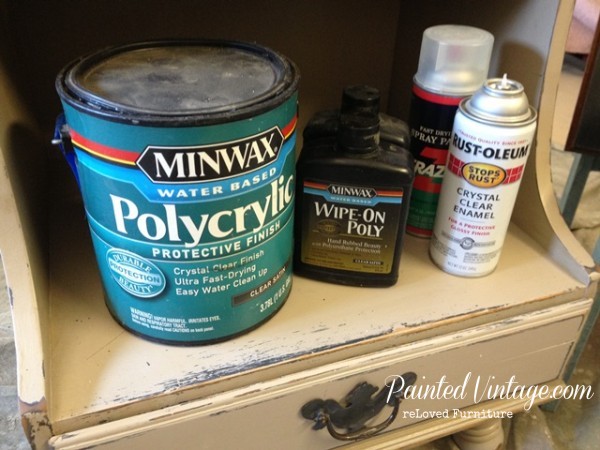To wax or not to wax?
Ah… The age old question: “To wax or not to wax over chalk paint?”
OK, so maybe it isn’t the question that’s been around for as long as chalk paint itself, but it is definitely a dilemma I’ve been facing more and more…
Nothing compares to the soft luster and rich glow of a freshly waxed piece of reLoved furniture!! However, applying wax over chalk paint is the most challenging, labor intensive and time consuming aspect of painting furniture with chalk and chalk-style paint.
Granted, not all waxes are created equal. Some waxes are downright difficult to work with and even require you to take a special class on proper application techniques.
Then there’s the durability issue.
Yes, I have an issue… Wax only offers minimal protection and wax is NOT permanent. Nor is it even semi-permanent. In fact, if it was a hair dye, it would be temporary!!
You see, wax wears off over time with use, leaving your beautiful chalk painted furniture all porous and exposed; a magnet for chocolaty little fingers and cheese puff smudges!
In order to maintain continued protection, wax needs to be reapplied every few months!
But wax isn’t THE ONLY option!
Why not go with a water-based polyurethane sealer, such as Varethane or Polycrylic over chalk paint?
These products are an excellent alternative, and offer far superior protection than a wax. A few coats of polycrylic will last YEARS beyond a few coats of wax, and can be much easier to work with.
Plus, polycrylics are more chemical resistant and are not heat sensitive like wax.
And unlike wax, if you ever chose to repaint your furniture, the polycrylic does not need to be 100% completely removed.
Don’t get me wrong, polycrylics are not without drawbacks.
Although they can have a yellowing effect over white and light colors, I personally have had good success with Varethane staying clear. Some waxes will yellow also, so that can still be an issue if you went that route. (I have also used clear spray-on sealers for smaller projects, with no issues what-so-ever!)
With the ease of application, I am finding water-based polyurethanes to be my go-to finish of choice over chalk painted furniture.
And if you are looking for a good alternative to do-it-yourself chalk-style paint, read my post on an Not So DIY Chalk Paint Recipe.
I’d love to hear your feedback! What is your sealer of choice over chalk paint and chalk-style paint on your reLoved furniture, and what, if any, challenges do you face?
**UPDATE**
Still have questions?? I posted an update with answers to all the most commonly asked questions I’ve received.
You can read it here: “Wax or Polycrylic Over Chalk Paint?”








Hi very new to chalk paint havent even done my first piece buf i am very confused lol. Im going to paint my manicuring table and need a finish that is durable and heat resistant. I would prefer something natural but i need something i can pick up at home depot or lowes even walmart tia
Hi ive just completed my first piece and have used craig & rose morris blue . How do I keep the chalk effect without wax which turns it a different colour .
I recently painted my first piece of furniture. I went with the plaster of Paris technique. I also used polycrylic. My question is what can I use beside the polycrylic if I want to keep the chalk paint finish. I found my piece to be a little complicated since I went with the color black. I want to paint other pieces, but now I don’t know since I would like to keep the chalk paint finish without adding shine to the piece. Thanks in advance
Have you considered trying the poly in a matte finish?
What a great thread. My daughter and I just painted a entryway bench in Annie Sloan chalk paint and used the Annie Sloan wax on top. It looks good now, but I’m wondering how he wax will hold up to 4 kiddos using it everyday. Sounds like painting over it with one of the poly coatings might be in our future. Thanks for sharing.
Painted my kitchen cabinets yesterday with Cecelia Caldwell wheat. What have heard in the polys that won’t yellow…?… Thank u! Jackie
Hi Jackie- my favorite poly to use is Varethane. It is a waterbased poly, and I have had excellent results with non-yellowing!
Do you spray the poly or brush?
You can do either, but I usually brush it.
Hi Sherri I purchased the varethane poly and it yellowed in spots. What do I need to do.. Use mineral spirits to remove or sand? Do I reaply and try it again? Any suggestions would be wonderful. This is for a customer. It is a bench and will receive a lot of wear and tear. I want to make sure it has a durable finish. Thank you
What were you applying the poly over? And what type of wood?
I used Annie Sloan chalk paint and then waxed with clear wax.. I love the look but fear that it will not be durable. Can I use a satin poly sealer directly over the wax or would I need to strip the wax first.
Hi Joancelle- unfortunately, you need to remove the wax if you want to apply a poly.
Thanks! I think I will not wax but use a poly sealer for future projects!
I know it has been said a lot, bit why can’t you spray a poly over a wax finish? What happens if you do?
The wax acts as a repellant. There would be adhesion issues.
Thanks for posting this – I recently used polycrylic on a pair of nightstands. The satin finish is lovely and durable. I’m painting a bookcase with chalk paint – and I *love* the ease of application and that I can paint inside. That said, you’ve solved my mental tussle over wax v. polycrylic. Thank you!
Awesome!! So glad to have helped!!
Just wondering where do you buy chalk paint. When I google it — it refers to chalkboard paint. Does it have to be at a speciality shop, hardward store or online. Anne Sloan — is it sold online. Any advice to this Canadian.
Hi Mary Kay, If you are looking for Annie Sloan Chalk Paint specifically, you can go to her website and then you will be able to find Canadian Retailers. You’ll be able to see which ones sell on line by the links to their websites! Hope that helps!
Since I’ve started using Chalk Paint .. I’ve tried using the Minwax wax and it’s a lot of work , the end result I like but just not the application .. I recently used the Polycrylic over a large piece I did and liked it .. Just not the brush marks I got .. I put a coat of minwax over and it seemed to soften the brush marks.
Now I’ve purchased the Annie Sloan Soft Wax and can’t wait to try it – expensive but I’m hoping it’s worth it …. Anyone else have experience with it over a homemade chalk paint?
check out Shabby Paints Vax and Revax. I use it over all brands of Chalk Paint and it is a dream come true!
Hi,
Thanks so much for great information! I have a question about glazing. Tonight I am painting my table with homemade chalk paint. I have painted quite a few pieces with this and have been very happy with results. But I would like to try glazing on the table. Can I apply the glaze directly to the chalk painted table? I was going to use a mixture of clear glaze and walnut stain- just scared this will cause the paint to rub off when I wipe the glaze off. Any advice would be appreciated:))
Hi Shannon,
My first questions are- Is the clear glaze water-based? and Is the walnut stain oil based? If so, I would not recommend mixing water and oil based products together. But to answer your question, yes, you can apply glaze directly over your homemade chalk paint. If the paint is completely dry, prior to applying the glaze, there should be no issues with the paint rubbing off, when you wipe the glaze. Good Luck with your project!
Thank you so much for all this great info! Just painted my kitchen cabs in Annie Sloan’s Graphite and really didn’t want to use the wax. I think I will use the varathane.
I was told today, by a Annie Sloan distributor, that if you use chalk paint, you can paint over the waxed finish.
Hello, Can you put a top coat of water-based polyurethanes over wax?
Hi Julie- No, you cannot put anything over wax, except more wax. If you choose to wax, that should be your final coat.
HELP!! I have been using two types of poly over chalk paint and they work wonderful until I paint a piece in cream or white which show tiny pices of black “hairs” or fibers. I have returned the poly and purchased a bend new brush I’m which I vacuum prior to using and make certain the cats inter that I pour into is lint and dust free! The fibers are still there and they show terribly on the finished white surface. This is extremely frustrating, I wouldn’t care so much if the piece was mine but in paint for paying customers and the perfectionist side of me can’t bear to deliver a finished piece with tiney black specs all over it! And advice or solution would be greatly appreciated!
I’m using polycrylic tonight and I’m having that issue. Did you figure it out?
What type of brush are you using? If you use a natural bristle brush with a water based coating, the bristles swell and start to break down. This is most noticeable when applying a clear finish because the tiny black hairs are not covered in paint and hidden, but are covered in clear and are visible. Also, those darker fibers really stand out against a white or lighter background. If you use a good quality synthetic bristled brush, you should not experience this issue.
Same here!! Making me nuts right now and has happened in the past. This dresser I’m doing is bright white…I’ve tried using Valspars craft sealant in the past, but it left the tops kind of sticky. So frustrating! Wish someone could help!
What type of brush are you using? If you use a natural bristle brush with a water based coating, the bristles swell and start to break down. This is most noticeable when applying a clear finish because the tiny black hairs are not covered in paint and hidden, but are covered in clear and are visible. Also, those darker fibers really stand out against a white or lighter background. If you use a good quality synthetic bristled brush, you should not experience this issue.
What type of brush are you using? If you use a natural bristle brush with a water based coating, the bristles swell and start to break down. This is most noticeable when applying a clear finish because the tiny black hairs are not covered in paint and hidden, but are covered in clear and are visible. Also, those darker fibers really stand out against a white or lighter background. If you use a good quality synthetic bristled brush, you should not experience this issue.